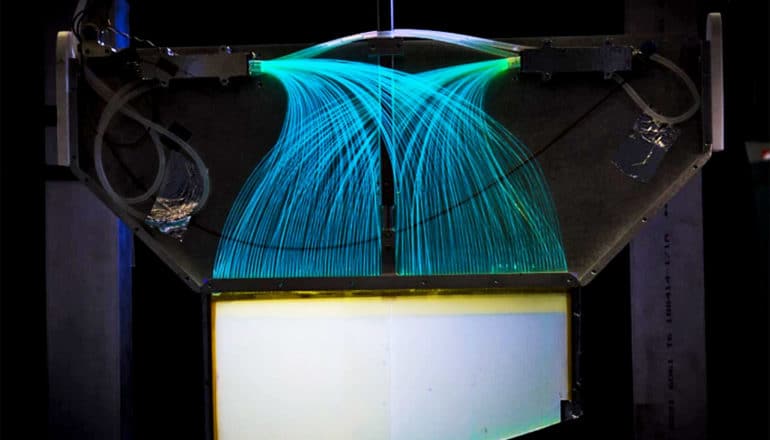
Physicists have announced the world’s most precise measurement of the neutron’s lifetime.
The scientific purpose of the experiment is to measure how long, on average, a free neutron lives outside the confines of atomic nuclei.
The results represent a more than two-fold improvement over previous measurements—with an uncertainty of less than one-tenth of a percent.
“This work sets a new gold-standard for a measurement that has fundamental importance to such questions as the relative abundances of the elements created in the early universe,” says David Baxter, chair of the physics department at Indiana University-Bloomington.
“The process by which a neutron ‘decays’ into a proton—with an emission of a light electron and an almost massless neutrino—is one of the most fascinating processes known to physicists,” says research scientist Daniel Salvat, who led the experiments at Los Alamos National Laboratory, where scientists conducted the research.
“The effort to measure this value very precisely is significant because understanding the precise lifetime of the neutron can shed light on how the universe developed—as well as allow physicists to discover flaws in our model of the subatomic universe that we know exist but nobody has yet been able to find.”
The Los Alamos Neutron Science Center Ultracold Neutron source produced the neutrons. The UCNtau experiment captures these neutrons, whose temperatures are lowered to nearly absolute zero, inside a “bathtub” lined with about 4,000 magnets. After waiting 30 to 90 minutes, researchers count the surviving neutrons in the tub as they’re levitated against gravity by the force of the magnets.
The unique design of the UCNtau trap allows neutrons to remain stored for more than 11 days, a significantly longer time than earlier designs, minimizing the need for systematic corrections that could skew the results of the lifetime measurements.
Over two years, the study’s researchers counted approximately 40 million neutrons captured using this method. These efforts were the thesis work of Francisco Gonzalez, who collected the data at Los Alamos as an Indiana University graduate student from 2017 to 2019, and led the analysis of the published result.
Salvat says the experiment’s results will help physicists confirm or deny the validity of the “Cabibbo-Kobayashi-Maskawa matrix,” which concerns subatomic particles called quarks and plays an important role in the widely accepted “standard model” of particle physics.
It will also help physicists understand the potential role that new ideas in physics, such as neutrons decaying into dark matter, may play in evolving theories about the universe, as well as possibly help explain how the first atomic nuclei were formed.
“The underlying model explaining neutron decay involves the quarks changing their identities, but recently improved calculations suggest this process may not occur as previously predicted,” Salvat says. “Our new measurement of the neutron lifetime will provide an independent assessment to settle this issue, or provide much-searched-for evidence for the discovery of new physics.”
Additional coauthors of the study in Physical Review Letters are from Argonne National Laboratory, Oak Ridge National Laboratory, Los Alamos National Laboratory, and Indiana University.
Source: Indiana University
The post Team makes most precise measurement of neutron lifetime appeared first on Futurity.
from Futurity https://ift.tt/3veIYCI
No comments:
Post a Comment